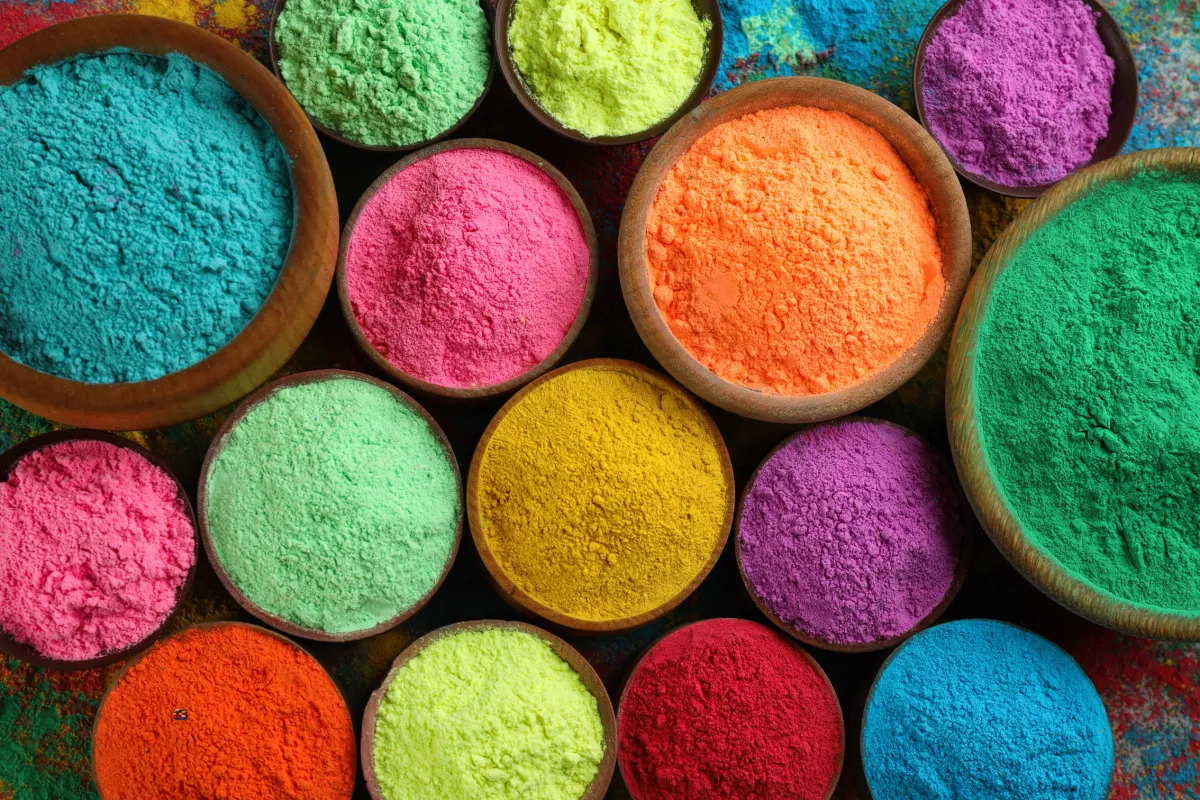Blog

The Dangers of Food Dyes
I’m not going to dilly-dally around this subject, we’re just going to dive right in. Artificial colors are found in nearly half of foodsmarketed towards kids. HALF.
I mean, what kid can resist neon-colored candy that basically glows in the dark? It’s hard to resist the vibrant colors especially when they areeverywhere. But, kids are not only more susceptible to desiring those rainbow frosted cupcakes, but also to the toxicityassociated with food dyes.
Back in 2008, the Center for Science in the Public Interest (CSPI)petitioned for the FDA to ban artificial food dyes due to their [proven] connection to increased behavioral issues in kids. By 2010, after new reportswere released, the CSPI concluded that nine artificial dyes approved in the U.S. are likely carcinogenic (i.e. cancer causing) and cause hyperactivity and other behavioral problems.
Yet, here we are 10 years later - with Americans consuming food dyes at a rate 5 timesgreater than just 60 years ago.
Artificial dyes are found in thousands of foods. The most obvious are breakfast cereals, candy, snacks, drinks, and vitamins. Fruity Cheerios, for example, contain 31 mg per serving. Trix cereals contain Yellow 6, Blue 1, and Red 40 -- 36 mg in all. Kraft Mac n Cheese? Glad you asked, 17mg per serving in the form of Yellow 5 and Yellow 6.
An even larger source are beverages. Powerade Orange Sports Drinks have 22.1mg, Sunny D Orange Strawberry has 41.5mg, & Kool-Aid Burst Cherry has 52.3mg of food dyes per serving. Ya’ll my palms are sweating. These numbers should give you heart palpitations.
What About Hidden Sources?
[non-organic] oranges-cue the rant in my head about buying organic foods
Non-organic oranges are often dipped in food dye to provide a uniform color amongst the bunch & to brighten them up. It’s all about that curb appeal.
Companies are able to cut costs of producing balsamic vinegar by using sugar, vinegar, & caramel color. It’s super important to note that the term ‘caramel color’ doesnotmean the manufacturer used actual caramel to color the product. We’ll talk more about this later.
Not all wheat bread is created equal. Some companies actually just add caramel color to white bread that contains a small amount of grains to give it a brown color. And, hey, now it’s wheat bread!
Why can’t we leave the pickles alone? Pickles, unfortunately, are another hidden source of food dyes - often containing Yellow 5 and Yellow 6.
We know balsamic dressing tends to contain caramel color, but that’s not the only culprit. French dressing often contains Yellow 6 and Catalina Dressing contains Red 40.
Yes, it’s true. Those bright pink or blue colors in our favorite gum aren't natural. Rather, it’s typically Yellow 5, Blue 5, or Beta-Carotene.
Proceed with caution when purchasing yogurts that contain fruit. They may throw some Blue 1 in there to enhance the ‘blueberry’ color.

The list goes on. But to keep your attention, we’ll move forward. The most important thing here is, as always, to read labels. I promise you, you can find a dye-free alternative to any candy, chip, dressing, gum, etc that contains dyes.
What’s The Purpose of Food Dyes?
Artificial colors are used to enhance and correct natural colors. Even further, as the International Association of Color Manufacturersstates “[artificial colors] provide a colorful identity to foods that would otherwise be virtually colorless” as well as compensating for natural color loss during storage & providing a way for pharmaceuticals and supplements to be easily identified.
The big 3 - Red 40, Yellow 5, & Yellow 6 - account for 90% of the dyes used in foods.
What Are The Dangers of These FDA Approved Food Dyes?
RED 40
‘Allura Red’ is made of petroleum or coal, Red 40 is a knowncarcinogenand has been directly linkedto hyperactivity, learning impairments, irritability, & aggressiveness in children.
Commonly found in:beverages, breakfast cereals, baked goods, flavored yogurts, chips, gelatin, dessert powders, candy, other foods, cosmetics, & medicines.
RED 3
Otherwise known as erythrosine, Red 3 has been shown to increase the risk of thyroid cancerand cause DNA damage in liver cells. Red 3 is also labeled a carcinogenby the FDA. In 1985, the acting commissioner of the FDA reportedthat Red 3 “has clearly been shown to induce cancer” and was “of greatest public health concern.” But, none-the-less, here we are in 2020 with 200,000 pounds of Red 3 being poured into our foods each year.
Commonly found in:sausage casings, cake decorations, baked goods, canned fruits, maraschino cherries, candy, popsicles, & medicines.
YELLOW 5
Otherwise known as tartrazine, Yellow 5 has been directly linked to hyperactivity, thyroid tumors, allergies, neurochemical & behavioral effects, insomnia, asthma, aggression & violent behavior, lymphomas, and chromosomal damage - which indicates a probable carcinogenicity.
Commonly found in:soft drinks, other beverages, baked goods, breakfast cereals, processed vegetables, chips, pickles, honey, mustard, gelatin desserts, pudding, ready to use frostings, dessert powders, candy, other foods, gum, cosmetics, & medicines.
YELLOW 6
Or ‘sunset yellow’, has significant health concerns consisting of hyperactivity, eczema, asthma, chromosomal damage, allergies, and thyroid tumors.
Commonly found in: breakfast cereals, sausages, baked goods, chips, orange soda, other beverages, hot chocolate mix, ready to use frostings, dessert powders, candy, gelatin desserts, other foods, cosmetics, & medicines.
BLUE 1
‘Brilliant Blue’ has known dangers that include causing kidney tumors in mice and is known to cause allergic reactions, nervousness, fatigue, & lack of concentration in humans.
Commonly found in: baked goods, ice cream, canned peas, jellies, candy, beverages, dessert powders, condiments, other foods, mouthwash, & medicines.
BLUE 2
‘Indigo Carmine’ causes major tumors, particularly brain gliomas, in mice (no human studies have been reported).
Commonly found in: Found in breakfast cereals, beverages, ice cream, candy, other foods, & medicines.
CITRUS RED 2
Citrus Red, even in minor amounts, is toxic to humans and increases the risk of bladder cancer & other tumors. The International Agency for Research on Cancer has labeled Citrus Red 2 as a carcinogen. Additionally, the World Health Organization Expert Committee on Food Additives has previously reported“this color should not be used as a food additive” due to the health concerns. However, the FDA deems that it poses little risk because the only approval in the United States is for coloring the skins of oranges. Hmmm…
Commonly found in: skin of Florida oranges

GREEN 3
This food dye is banned in the EU and other countries as it has been associated with an increased risk of bladder cancer.
Commonly found in: canned peas, other processed vegetables, fish, beverages, pudding, dessert powders, ice cream, sherbets, sorbet, cotton candy, other candy, medicines, personal care products, & cosmetics.
CARAMEL COLOR
Federal regulations currently allow four types of artificial caramel coloring, two of which have been flagged by the Center for Science in Public Interest for being made with ammonia. Government-led studies conclude caramel coloring causes liver, lung, leukemia, and thyroid cancers in lab rats and mice. The National Toxicology Program(a division of the National Institute of Environmental Health Sciences) states there is “clear evidence” that 2-methylimidazole and 4-methylimidazole, two components of caramel coloring, are animal carcinogens. Any chemicals that cause cancer in animals also pose a threat to humans.
Also, important to note, California has added 4-methylimidazole (4-MI) to the state’s list of “chemicals known to the state to cause cancer.” Under the state’s Proposition 65, foods or products containing more than certain levels of cancer-causing chemicals must carry warning labels. For 4-MI, that level is 16 micrograms per person per day. To put that into comparison, popular brands of cola contain 200 micrograms of 4-MI per 20 ounce bottle.
Commonly found in: beer, soft drinks (highest in colas), soy sauce, gravies, other sauces, licorice, dark breads, chocolate, cookies, cough drops, liquor, chips, doughnuts, fruit preserves, ice cream, pickles, dressings, custards, and more.
*To note Red 40, Yellow 5 and Yellow 6 have also been banned in Europe & Australia. See a list of other banned ingredients, here. Additionally, as of July of 2010, most foods that contain artificial dyes in Europe must carry label warnings stating that they may cause hyperactivity in children
Let’s Talk Drugs
If you open your medicine cabinet at home, chances are you have some red cough drops, orange ibuprofen, and some colored antacid tablets. Pharmaceutical companies use dyes in their medicines for a few reasons. One is to attract the consumer - they want their medication to look pretty & fun. The second is to differentiate dosages. Neither of these reasons are to better the drug or benefit the patient, yet, according to an MIT study, 33% of all medications contain at least one chemical dye.
Red 40is an inactive ingredient in most cherry, strawberry, or any type of berry flavored liquid medication.
Yellow 6is commonly used in kid’s cough syrup & anti-inflammatories.
Yellow 10, otherwise known as Yellow 10 Aluminum Lake, which isnotapproved as a food coloring dye additive in the United States, is commonly used in medications and cosmetics. - such as Dulcolax.
What Can We Do?
ALTERNATIVES
The best alternative, other than avoiding them all together, is plant-based colorings.In the United Kingdom, Fanta Orange Soda is colored with pumpkin and carrot extracts, while the United States version uses Red 40 and Yellow 6. McDonald’s strawberry sundaes use, wait for it, real strawberries in Britain, while Red 40 is used in the United States.
🤦♀️🤦♀️🤦♀️
A semi-rant… General Mills removed artificial dyes from Trix in 2016 - after the link between food dye and ADHD in children became inevitable. The company rather used naturally derived turmeric for color and, needless to say, Trix lost its signature neon hue. Welp, they also lost consumers after making the change so General Mills recently brought back the artificial dyes to satisfy the fans.
I’m sorry, what? Please review the proven consequences of food dyes & tell me what’s wrong with this picture.
I digress. Anyways, natural dyes that can make foods equally as pretty include: beets, carrots, blueberries, grapes, red cabbage, paprika & turmeric to name a few.

Make Stuff at Home
Ya’ll know I’m an ingredient junkie. So, to avoid dyes, make sure to read all the ingredients in what you’re buying. If you’re the creative type, you can also make certain foods from scratch, including:
USE COMPOUNDING PHARMACIES
As a practitioner, I prefer to send any prescriptions to a compounding pharmacy. Not all medications can be compounded (i.e. made in-house by a certified compounding pharmacy), but a ton can. When the medication is ordered this way, us practitioners can request for it to be dye-free, preservative-free, gluten-free...all the things free. I encourage you to ask your practitioner to send your script to your local compounding pharmacy!
Despite all of the concerns mentioned above, 15 million pounds of synthetic dyes are dumped into our food every year. The reality is, these synthetic chemicals do absolutely zero for us. They don’t improve the nutritional quality. They don’t improve the safety. Rather, they trigger behavioral problems in children and, most, are cancer-causing toxic petrochemicals.
These carcinogenic food dyes bombard our food supply. Considering theonlyfunction of artificial dyes is to please our eyeballs, are the proven dangers and unnecessary risks worth it to you?
The Discovery Doc - Dr. CeCe Brooks - Atlanta Holistic NP
Copyright 2022 The Discovery Doc, LLC®. All Rights Reserved.




